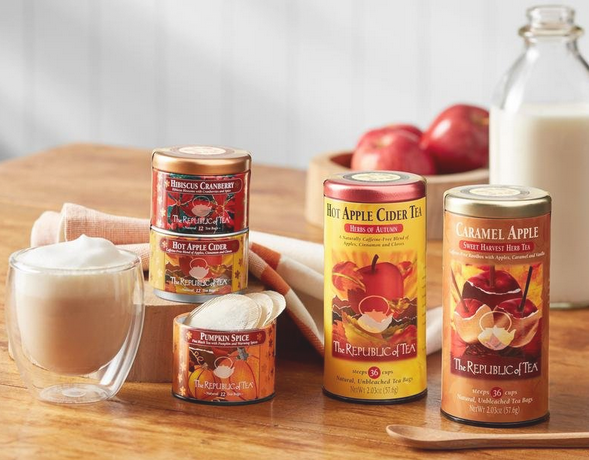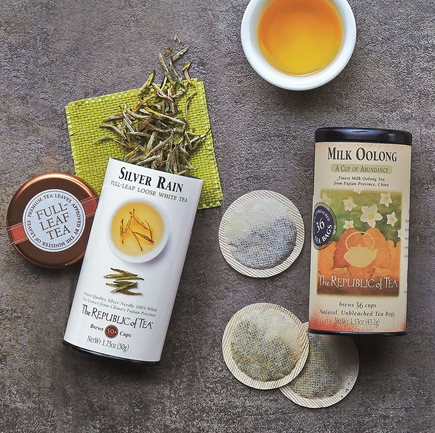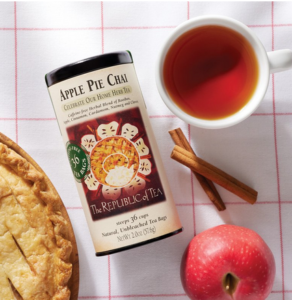By following these five key steps, you can steep the perfect cup of tea every time.
2. Heat Water to the Correct Temperature
3. Measure the Right Quantity of Tea
4. Pour the Water Over the Tea Leaves
5. Steep for the Appropriate Amount of Time



We the people of The Republic of Tea take great delight in the knowledge that tea drinking brings about more than a pleasurable experience. For centuries, tea has been associated with good health. Now more than ever, scientific research supports that connection.
Green tea, black tea, white tea, and Oolong tea all have antioxidants. These antioxidants are polyphenols, specifically catechins. Studies from institutes like Purdue, Linus Pauling, Harvard and the Medical College of Wisconsin have shown a variety of benefits from drinking tea – greater immunity, improved cognitive functions, a decreased risk of cardiovascular problems, less fatigue, lower blood pressure, a slowingnof the aging process, and reduced stress. Recent research from Shandong University in China concluded that green tea may even help ease depression.
Find your favorite teas from The Republic of Tea, sip often, and be well.
1. Use Fresh, Filtered Water
Steeping the perfect cup of tea begins with water — the element that brings tea to its full potential. Fresh water yields a better cup, so avoid reusing water that has been previously boiled. Likewise, the minerals in unfiltered tap water can negatively affect the taste. For best results, fill your kettle with filtered, spring or bottled water.
2. Heat Water to the Correct Temperature
Standard tea steeping instructions often begin with “boil water,” but there is actually some nuance to these guidelines. If you are preparing black tea, oolong tea, rooibos tea or other herbal teas, you can go ahead and heat your tea to a full rolling boil, up to 212 degrees Fahrenheit.
But these high temperatures can scorch delicate green tea or white tealeaves, resulting in an unpleasant bitter taste. When preparing these teas, bring your water to just short of boiling — around 165 to 185 degrees Fahrenheit.
Furthermore, while the microwave will do in a pinch, it is not recommended for best tea steeping results. We always recommend heating your water in a proper tea kettle. This is because the boiling process is responsible for oxygenating the water, which helps to draw out the flavors of the tea. Microwaves heat the water too quickly and unevenly, and do not properly oxygenate the water. This can result in flat, dull or bitter-tasting tea.
3. Measure the Right Quantity of Tea
In general, we recommend using one tea bag or one teaspoon of full-leaf loose tea or herbs per six-ounce cup. However, if you desire a stronger flavor, you may add more tea leaves or an extra tea bag to your cup. This is the preferred method for increasing the strength of your tea rather than lengthening the steeping time (or squeezing the tea bag), which can make the tea taste bitter.
4. Pour the Water Over the Tea Leaves
If you are using a teapot, preheat it by pouring some of the heated water into the empty teapot and swirling it around, allowing it to warm the pot. Then, discard the water. This step helps to protect your teapot from cracking due to the sudden change in temperature.
Add your tea bag(s) or tea leaves to your cup or preheated teapot, then pour the heated water over the tea leaves. This is the preferred order for preparing tea, rather than adding tea leaves or tea bags to a cup or pot that already has hot water in it. If you are using a tea infuser, ensure that it is fully submerged beneath the water while steeping.
5. Steep for the Appropriate Amount of Time
Depending on the type of tea you are preparing, the ideal steeping time will vary. This chart offers general guidelines for steeping the perfect cup of tea:
Both under-steeping and over-steeping may negatively affect the taste of your tea. Not steeping for long enough will yield a weak, watery cup that lacks depth of flavor, while steeping for too long may cause your infusion to become bitter and overly acidic. For best results, stay within the recommended range on the tea package.
